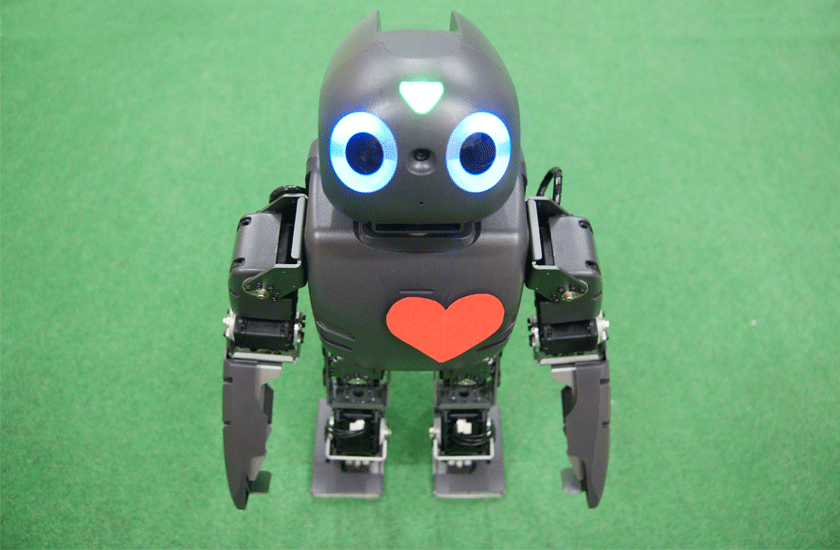
Emotional AI and Companion Robots

This project stream in the Newcastle Robotics Lab investigates how emotion and affect can be implemented in artificial systems in order to achieve a basic sense of empathy and simulate the perception of aesthetics.
As an initial question we investigated what features and pattern of the visual environment are known to affect the (emotional or affective) state of the human body and how these concepts can be implemented on a robot.
We soon reached the boundaries of what is known in science and psychology about emotions and affect and since then we further investigate associated fundamental questions in collaboration with architects and neuroscientists.
Investigators
Stephan K. Chalup, Michael J. Ostwald, Peter Walla, Aaron Wong, Kenny Hong, Trent Houliston
We currently seek funding to expand this project and develop a physical working companion robot.
A.S.W. Wong, S. Nicklin, K. Hong, S.K. Chalup, and P. Walla (2013) 'Robot emotions generated and modulated by visual features of the environment', Proceedings of the 2013 IEEE Symposium on Computational Intelligence for Creativity and Affective Computing, CICAC 2013 - 2013 IEEE Symposium Series on Computational Intelligence, SSCI 2013, pp. 9-16, IEEE 2013. link.
Kenny Hong (2013) "Scene perception using machine pareidolia of facial expressions". PhD thesis in Computer Science. School of Electrical Engineering and Computing. The University of Newcastle, Australia.
Kenny Hong, Stephan K. Chalup and Robert A.R. King (accepted 2014) "Affective Visual Perception using Machine Pareidolia of Facial Expressions". IEEE Transactions on Affective Computing.
K. Hong, S.K. Chalup, R.A.R. King, and M.J. Ostwald (2013) 'Scene perception using pareidolia of faces and expressions of emotion', Proceedings of the 2013 IEEE Symposium on Computational Intelligence for Creativity and Affective Computing, CICAC 2013 - 2013 IEEE Symposium Series on Computational Intelligence, SSCI 2013, pp. 1-8, IEEE 2013. link.
Stephan K. Chalup, Michael J. Ostwald and Peter Walla (2012) "Simulating Mechanisms of Emotion Associated with Visual Perception of Urban Space: An Artificial Agent's Perspective." Presentation at the Academy of Neuroscience for Architecture (ANFA) 2012 Conference. Salk Institute, La Jolla, 2012.
Aaron S. W. Wong, Stephan K. Chalup, Shashank Bhatia, Arash Jalalian, Jason Kulk, Steven Nicklin, and Michael J. Ostwald (2012) Visual Gaze Analysis of Robotic Pedestrians Moving in Urban Space. Architectural Science Review, 55(3), pp. 213-223.
S.K. Chalup, K. Hong, and M. Ostwald (2010) 'Simulating pareidolia of faces for architectural image analysis', International Journal of Computer Information Systems and Industrial Management Applications 2, pp. 262-278. link.
S.K. Chalup and M. Ostwald (2009) 'Anthropocentric biocybernetic computing for analysing the architectural design of house facades and cityscapes', Design Principles & Practices: An International Journal 3(5), pp. 65-80. link.
Michael R. Dickinson and Peter Turner. 'Development of a biomimetic robotic bear: or is a bare bear bearable?', IEEE Robio 2008: IEEE International Conference on Robotics and Biomimetics. ROBIO 2008 Proceedings (Bangkok, Thailand 21-26 February, 2009) p. 7-12 link.
Stephan K. Chalup, Kenny Hong, and Michael J. Ostwald. 'A face-house paradigm for architectural scene analysis.' CSTST 2008: Proceedings of The Fifth International Conference on Soft Computing as Transdisciplinary Science and Technology, pages 397-403. ACM, 2008. link.
Chris Lawrence, Michael R. Dickinson, and Stephan Chalup. 'Designing charm: Harnessing the aective power of form in robotic development', In ConnectED 2007 International Conference on Design Education, Sydney, 2007. link.
S. K. Chalup, M. Dickinson, R. Fisher, R. H. Middleton, M. J. Quinlan, and P. Turner. 'Proposal of a kit-style robot as the new standard platform for the four-legged league', In Australasian Conference for Robotics and Automation ACRA 2006. ARAA (on-line), 2006. link.
The University of Newcastle acknowledges the traditional custodians of the lands within our footprint areas: Awabakal, Darkinjung, Biripai, Worimi, Wonnarua, and Eora Nations. We also pay respect to the wisdom of our Elders past and present.
